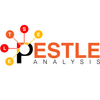The STEEP analysis tool is a framework for assessing how Social, Technological, Economic, Environmental, and Political external factors affect a business.
Do you know what PESTLE analysis is? Then, understanding what STEEP analysis is will be easy since STEEP is an anagram of PESTLE minus the 'L' factor. But even for beginners in business analysis, it only takes 5 minutes to learn everything you need to know about the STEEP analysis framework. Let me explain.
What is STEEP Analysis?
STEEP analysis is a framework for assessing how Social, Technological, Economic, Environmental, and Political external factors affect a business. It's a strategic planning tool used by business and project managers to help them make better decisions.
These five factors are so-called external factors. External factors are events that a business cannot control but affect its operations and success. These outside forces can have a positive or a negative impact on the business. And they are the exact opposite of internal factors.
STEEP analysis extensions or variations are:
Now, let me explain each one briefly before coming up with a STEEP analysis example.
STEEP Analysis Factors
Social Factors
For these factors, I have to look carefully at the social and cultural changes as external factors that affect the business environment. It is vital to point out the trends and patterns of society. Learn more about them in our dedicated page on social factors here.
Technological Factors
Technological factors are external factors related to the existence, availability, and development of technology. These could include everything related to technology. Learn more about them in our dedicated page on technological factors here.
Economic Factors
Economic factors are external factors that influence the economy’s performance, which in turn can affect businesses and individuals. Learn more about them in our dedicated page on economic factors here.
Environmental Factors
Environmental factors are external factors that describe how our planet and ecosystem can impact the organization. Since we cannot control the weather, organizations need to adapt their strategies accordingly. Learn more about them in our dedicated page on environmental factors here.
Political Factors
Political factors are external factors such as government, trade and tax policies, general political issues, changes in leadership, regulation, and political trends. They are very important as they influence crucially the business’ operations. Learn more about them in our dedicated page on political factors here.
STEEP Analysis Example: Nike
Say I want to conduct a STEEP analysis of Nike. Once I do my research for each type of STEEPLE's external factors, I'll use the STEEP analysis template. Since here I'm only demonstrating how to do a STEEP analysis, I'm using part of my findings from the research I did for Nike's PESTLE analysis. Make sure to check that out for the complete list of my reports (you'll also find Nike's Legal external factors there!).
Social Factors affecting Nike
- Demographic Shifts: Populations in developed countries are aging, whereas emerging markets enjoy young, growing populations. These should definitely affect Nike’s target markets and product offerings.
- Globalization vs. Localization: While Nike sells its products worldwide, offering a product influenced by local culture will likely lead to more locals trusting the brand.
Technological Factors affecting Nike
- Innovation in Product Design and Materials: New technologies can be used to improve Nike's product design or features. And that's what Nike did. Back in 2014 Nike combined 3D knitting with 3D printing in their Nike Vapor Ultimate Cleat American football boot! And Nike isn’t pausing innovation any time soon, as Nike launched the Air Max Dn on March 2024, redefining what it feels to walk on Air!
- Virtual and Augmented Reality (VR/AR): VR and AR technologies offer Nike innovative ways to engage with consumers, from virtual product try-ons to immersive brand experiences. These technologies can enhance online shopping experiences and drive engagement in retail spaces.
Economic Factors affecting Nike
- Exchange Rates: As a global company, Nike is exposed to currency risk.
- Supply Chain Costs: I suppose making Nike shoes involves a lot of raw material processing and transportation. This surely will have an effect on production expenses. Rising costs can squeeze margins unless offset by price increases or operational efficiencies.
Environmental Factors affecting Nike
- Waste Reduction and Recycling: The world is moving toward a greener future. Inevitably, comes the issue of waste in the fashion industry. Nike launched the Reuse-A-Shoe program to recycle old sneakers into sports surfaces, as Nike adapted to the environmental trend.
- Climate Change and Operational Impact: Nike suppliers' factories are, without a doubt, harming the environment. As Nike needs to be an environmentally responsible company, their business plans must include actions to minimize the impact on the climate.
Political Factors affecting Nike
- Public Health Policies: The recent global pandemic highlighted the impact of public health policies on operations. Lockdowns, store closures, and restrictions on gatherings affected sales channels. For instance, in Q4 2020 Nike’s revenue had a 38% decrease YoY but at the same time Nike’s digital sales increased by 75%. Meanwhile, health and safety regulations impacted Nike’s manufacturing process and distribution.
- International Relations: The relationship between countries can affect Nike’s operations. For example, geopolitical tensions can disrupt supply chains or alter market access. Positive diplomatic relations, on the other hand, might open up new opportunities. An example here was Nike CEO saying that Nike is a brand of China for China during the U.S.-China trade war.
Since we know now what factors affect Nike and how (positively or negatively) thanks to the STEEP analysis tool, we can make recommendations for planning in the future. Other STEEP analysis examples we've done here at PESTLEanalysis are for:
Why is the STEEP Analysis framework important?
STEEP is commonly used to gain insight into past, current, and future external environment developments. These external factors can be crucial during times of uncertainty, information overload, and disorganization.
So, STEEP analysis is conducted when business managers are unsure about how the market will react to changes in specific factors. It's also used when a company receives a constant flow of information from the external environment or when firms seem confused about the external environment.
Which STEEP factors you should rely on more depends highly on your field of interest or aim. B2C firms, for example, are most likely to focus on social factors. Large non-profit companies, on the other hand, may be more concerned about political factors. The most crucial factors are those that are most likely to alter and affect entities directly.
The STEEP analysis can be conducted by anyone who wants to control developments in the contextual factors. It can be carried out by an individual but is most commonly done by a firm’s corporate level or a division. Educational institutes may also choose to do STEEP analysis.
How to conduct a STEEP analysis

However, it is important to follow some steps to get the best results in the time invested in executing the STEEP analysis. A 5-step plan has been given below:
Step 1: Understand the factors being analyzed
This step urges the analyst to comprehend the factors of the environment which are being evaluated. Individuals or companies should try to answer questions about the following:
- What are the key trends and events within the factor, and what evidence supports these trends?
- How have these trends evolved historically?
- What is the nature of change in the trends you noticed?
- What kind of effects do the trends have on the organization?
Step 2: Assess the interrelationship between different trends
This step entails properly assessing the interrelationship that trends have with the external environment factors. As an analyst, you are expected to find out what the conflicts between the trends are and what the interrelationships between the trends are like.
Step 3: Relate the trends to issues
Analysts should identify the trends that significantly boost or hinder the company’s process of reaching its objectives. The best approach to executing this step is to create a list of possible trends and then gradually shrink it down to the main issues.
Step 4: Forecast the upcoming direction of issues
At this stage, you are expected to take the STEEP analysis beyond the information you collected in prior steps. Using your expertise and collected data to determine what the driving forces behind the issues are. Try to identify the causes and symptoms of the trends to find the driving forces.
It is true that this task can be quite time-consuming and even frustrating at times. Yet, when the step is completed, it can offer a wealth of insights that will guide the firm’s decision-making process.
Step 5: Derive the implications
Deriving implications is a crucial step. It will provide a unique opportunity to make conclusions or decisions about the external environment. It can help deduce how the factor can affect any present and future strategic initiatives.
Remember, good conclusions will leave your organization with "food for thought" and the implications that should be addressed when executing a strategic plan.
When external environment factors like downturns in the economy and lack of investment have their toll on a company's strategic options, the STEEP analysis can help get a better understanding of how each factor affects the planning process. The tool then helps make better decisions.


